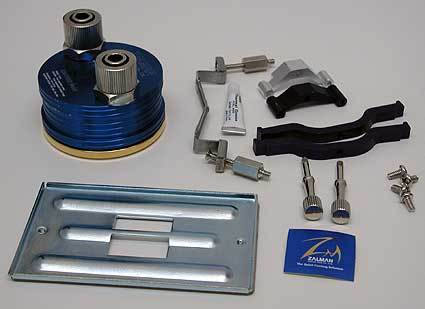Hands Across Four Water Cooling Systems
Installation
Installation is quite easy and is done in almost no time. It's only fastening the CPU cooler and the sleeves that take up any real amount of time when drilling a hole into the case. If the sleeves are to be fastened instead of using a slot bracket, this is also completed within a few minutes.
The water block and retention clips for the P4 and AthlonXP as well as the backplane for the Athlon64.
The water block is tightened down by two screws and a fastening clip, which is attached to two aluminum rails, similar to the CNPS7000 air cooler. It is only easy with the Pentium 4 - with the AthlonXP and the Athlon64 the motherboard has to be removed for installation. Here, too, the dividers and backplane similar to the CNPS7000 are employed.
You just set up the cooling tower in a suitable spot and connect it with the hoses leading to the water block. Now all that's left is to integrate the flow indicator into the circuit in a suitable place - all the more important as the user is unable to see through the opaque hoses and check if the water is flowing. After connecting all the hoses the water can be poured in. You should keep a large container of distilled water at hand as the reservoir alone handles 2.5 liters of water. No water cooler has ever gulped down an amount that large before in our lab. Filling up is very easy thanks to the large fill opening, despite the high liquid volume. Following that all that is left is to plug in the power cable and turn the water cooler on. After only a few seconds the water distributes itself evenly and without bubbles. Without a flow indicator you wouldn't necessarily know if the cooler is actually working. The hose is not transparent, the pump can hardly be heard, and there are no other sources of noise like fans and such.
Cooling Performance
Determining cooling performance required extreme patience with the Zalman cooler. While an air cooler shows almost no temperature changes after a quarter hour of operation at full throttle, testing water coolers takes significantly longer as the water first has to warm up. On average at least two to three hours go by before no major temperature changes can be observed. We had to run the test system under full load conditions to get an impression of the Zalman cooler's performance due to the enormous amount of water it uses. However, despite days of operation, the CPU temperature did not rise beyond 43°C, so the concept works. With thermal resistance of 0.26 K/W, the cooler manages a respectable result. The Reserator 1 really does operate nearly without sound at maximum performance. The sound generated by the Reserator 1 is lower than regular room noise in a typical home or office environment. Zalman offers special water blocks for graphics cards, but only a larger, passive cooler for the Northbridge. So even with this water-cooling system you can't get around having to use a small case fan to produce a slight air current at a low rpm level. After all it's only the CPU in the PC interior that "generates" heat.
Get Tom's Hardware's best news and in-depth reviews, straight to your inbox.
